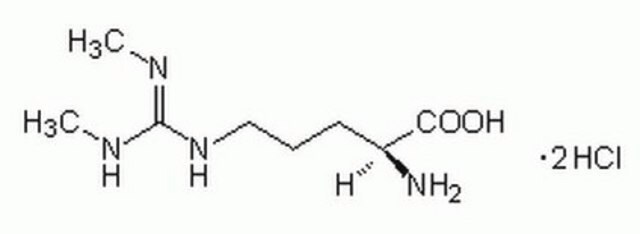Kluczowe dokumenty
11039
L-Arginine monohydrochloride
≥99.5% (AT), suitable for ligand binding assays, BioUltra
Synonim(y):
(S)-(+)-2-Amino-5-[(aminoiminomethyl)amino]pentanoic acid monohydrochloride, (S)-(+)-Arginine hydrochloride
About This Item
Polecane produkty
Nazwa produktu
L-Arginine monohydrochloride, BioUltra, ≥99.5% (AT)
linia produktu
BioUltra
Próba
≥99.5% (AT)
Formularz
powder or crystals
aktywność optyczna
[α]20/D +22.0±0.5°, c = 5% in 5 M HCl
metody
ligand binding assay: suitable
zanieczyszczenia
insoluble matter, passes filter test
≤0.3% foreign amino acids
pozostałość po prażeniu
≤0.05%
strata
≤0.05% loss on drying, 20 °C (HV)
kolor
colorless or white
pH
5.5-7.0 (25 °C, 1 M in H2O)
mp
220-230 °C
rozpuszczalność
H2O: 1 M at 20 °C, clear, colorless
gęstość
1.42 g/cm3 at 20 °C
ślady anionów
sulfate (SO42-): ≤50 mg/kg
ślady kationów
Al: ≤5 mg/kg
As: ≤0.1 mg/kg
Ba: ≤5 mg/kg
Bi: ≤5 mg/kg
Ca: ≤10 mg/kg
Cd: ≤5 mg/kg
Co: ≤5 mg/kg
Cr: ≤5 mg/kg
Cu: ≤5 mg/kg
Fe: ≤5 mg/kg
K: ≤50 mg/kg
Li: ≤5 mg/kg
Mg: ≤5 mg/kg
Mn: ≤5 mg/kg
Mo: ≤5 mg/kg
Na: ≤50 mg/kg
Ni: ≤5 mg/kg
Pb: ≤5 mg/kg
Sr: ≤5 mg/kg
Zn: ≤5 mg/kg
λ
1 M in H2O
absorpcja UV
λ: 260 nm Amax: ≤0.2
λ: 280 nm Amax: ≤0.1
ciąg SMILES
Cl[H].N[C@@H](CCCNC(N)=N)C(O)=O
InChI
1S/C6H14N4O2.ClH/c7-4(5(11)12)2-1-3-10-6(8)9;/h4H,1-3,7H2,(H,11,12)(H4,8,9,10);1H/t4-;/m0./s1
Klucz InChI
KWTQSFXGGICVPE-WCCKRBBISA-N
Szukasz podobnych produktów? Odwiedź Przewodnik dotyczący porównywania produktów
Zastosowanie
Działania biochem./fizjol.
Kod klasy składowania
13 - Non Combustible Solids
Klasa zagrożenia wodnego (WGK)
WGK 1
Temperatura zapłonu (°F)
Not applicable
Temperatura zapłonu (°C)
Not applicable
Środki ochrony indywidualnej
dust mask type N95 (US), Eyeshields, Gloves
Wybierz jedną z najnowszych wersji:
Masz już ten produkt?
Dokumenty związane z niedawno zakupionymi produktami zostały zamieszczone w Bibliotece dokumentów.
Klienci oglądali również te produkty
non-adrenergic, non-cholinergic relaxation of the mouse
anococcygeus muscle
Nasz zespół naukowców ma doświadczenie we wszystkich obszarach badań, w tym w naukach przyrodniczych, materiałoznawstwie, syntezie chemicznej, chromatografii, analityce i wielu innych dziedzinach.
Skontaktuj się z zespołem ds. pomocy technicznej






